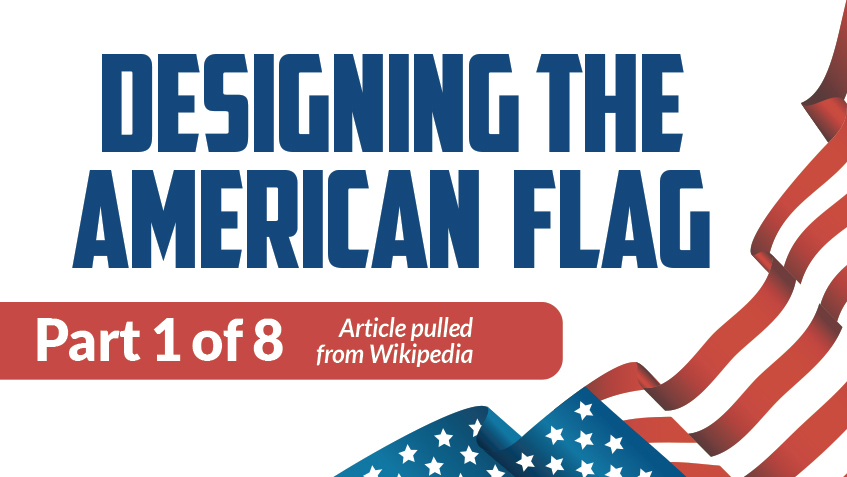Happy Veterans Day! Honor your vets this day by learning about the Designing The American Flag
The current design of the U.S. flag is its 27th; the design of the flag has been modified officially 26 times since 1777. The 48-star flag was in effect for 47 years until the 49-star version became official on July 4, 1959. The 50-star flag was ordered by then president Eisenhower on August 21, 1959, and was adopted in July 1960. It is the longest-used version of the U.S. flag and has been in use for over 63 years.
The First Flag
The first flag resembling the modern stars and stripes was an unofficial flag sometimes called the Grand Union Flag, or “the Continental Colors”.
It consisted of 13 red-and-white stripes, with the Union Jack in the upper left-hand-corner. It first appeared on December 3, 1775, when it flew aboard Captain Esek Hopkin’s flagship Alfred in the Delaware River. It remained the national flag until June 14, 1777. The “Grand Union Flag” has historically been referred to as the first national flag of the United States.
The Continental Navy raised the Colors as the ensign of the fledgling nation in the American War for Independence. The name “Grand Union” was first applied to the Continental Colors by George Henry Preble in his 1872 book known as History of the American Flag.
The flag closely resembles the flag of the British East India Company during earlier in that era. Sir Charles Fawcett argued in 1937 that the company flag inspired the design of the U.S. flag. Benjamin Franklin once gave a speech endorsing the adoption of the company’s flag by the United States.
This was a way of symbolizing American loyalty to the Crown as well as the United States’ aspirations to be self-governing, as was the East India Company. Some colonists also felt that the company could be a powerful ally in the American War of Independence, as they shared similar aims and grievances against the British government’s tax policies. The resemblance is obvious, and some of the Founding Fathers of the United States were aware of the East India Company’s activities and of their free administration of India under Company rule.
Flag Resolution of 1777…
On June 14, 1777, the Second Continental Congress passed the Flag Resolution which stated: “Resolved,That the flag of the thirteen United States be thirteen stripes, alternate red and white; that the union be thirteen stars, white in a blue field, representing a new constellation.” Flag Day is now observed on June 14 of each year. Both the stripes (barry) and the stars (mullets) have precedents in classical heraldry. Mullets were comparatively rare in early modern heraldry. A widely repeated theory is that the design was inspired by the coat of arms of George Washington’s family, which includes three red stars over two horizontal red bars on a white field. Despite the similar visual elements, there is “little evidence” or “no evidence whatsoever” to support the claimed connection with the flag design.
The first official U.S. flag flown during battle was on August 3, 1777, at Fort Schuyler during the Siege of Fort Stanwix... Massachusetts reinforcements brought news of the adoption by Congress of the official flag to Fort Schuyler. Soldiers cut up their shirts to make the white stripes; scarlet material to form the red was secured from red flannel petticoats of officers’ wives, while material for the blue union was secured from Capt. Abraham Swartwout’s blue cloth coat. The 1777 resolution was probably meant to define a naval ensign. In the late 18th century, the notion of a national flag did not yet exist or was only nascent. The flag resolution appears between other resolutions from the Marine Committee.
The Flag Resolution did not specify any particular arrangement, number of points, nor orientation for the stars and the arrangement or whether the flag had to have seven red stripes and six white ones or vice versa. The appearance was up to the maker of the flag. One arrangement features 13 five pointed stars arranged in a circle, with the stars arranged pointing outwards from the circle (as opposed to up), the Betsy Ross flag. Experts have dated the earliest known example of this flag to be 1792 in a painting by John Trumbull.
Despite the 1777 resolution, the early years of American independence featured many different flags. Most were individually crafted rather than mass produced. While there are many examples of 13-star arrangements, some of those flags included blue stripes as well as red and white.
Benjamin Franklin and John Adams, in an October 3, 1778, letter to Ferdinand I of the Two Sicilies, described the American flag as consisting of “13 stripes, alternately red, white, and blue, a small square in the upper angle, next to the flagstaff, is a blue field, with 13 white stars, denoting a new Constellation”. John Paul Jones used a variety of 13-star flags on his U.S. Navy ships including the well-documented 1779 flags of the Serapis and the Alliance. They were two of the earliest known flags of 13 stars.
Read more articles from VOM Magazine here: https://www.veteransoutreachministries.org/vom-magazine/





